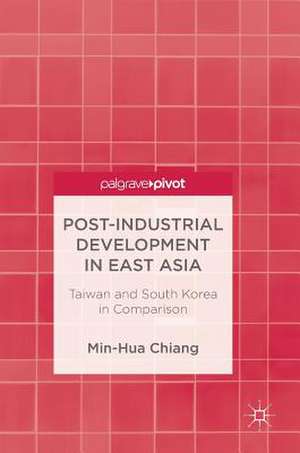Post-Industrial Development in East Asia: Taiwan and South Korea in Comparison
Autor Min-Hua Chiangen Limba Engleză Hardback – 11 iun 2018
Researchers in the fields of global political economy, Asian economic development and East Asian studies will find this book a fresh and invaluable contribution to the literature. The book will also be of value to policy makers in developing countries in drafting their national development policies, diplomats conducting economic diplomacy with Taiwan and South Korea, and business people planning to expand their business interests in Asia.
Preț: 419.21 lei
Nou
Puncte Express: 629
Preț estimativ în valută:
80.22€ • 85.78$ • 66.88£
80.22€ • 85.78$ • 66.88£
Carte tipărită la comandă
Livrare economică 18 aprilie-02 mai
Preluare comenzi: 021 569.72.76
Specificații
ISBN-13: 9789811302732
ISBN-10: 9811302731
Pagini: 181
Ilustrații: XI, 165 p. 10 illus.
Dimensiuni: 148 x 210 mm
Greutate: 0.37 kg
Ediția:1st ed. 2018
Editura: Springer Nature Singapore
Colecția Palgrave Pivot
Locul publicării:Singapore, Singapore
ISBN-10: 9811302731
Pagini: 181
Ilustrații: XI, 165 p. 10 illus.
Dimensiuni: 148 x 210 mm
Greutate: 0.37 kg
Ediția:1st ed. 2018
Editura: Springer Nature Singapore
Colecția Palgrave Pivot
Locul publicării:Singapore, Singapore
Cuprins
1. Introduction.- 2. Sustaining Taiwan’s and South Korea’s Post-Industrial Economic Growth: the China Factor.- 3. The Changing Role of SMEs in Taiwan’s and South Korea’s Economies.- 4. Comparing Governments’ Policies in Promoting Economic Growth (I): Industrial Upgrading Policies.- 5. Comparing Governments’ Policies in Promoting the Economic Growth (II): Free Trade Policy.- 6. New Challenges Ahead (I): Growing Income Inequality.- 7. New Challenges Ahead (II): Aging Demography.- 8. Conclusion.
Notă biografică
Min-Hua Chiang is research fellow at the East Asian Institute, National University of Singapore. She obtained her PhD in Economics from Université Pierre Mendès-France, now part of Université Grenoble Alpes in 2008. Her research interests include Asia-Pacific regionalism, trade and investment, and issues related to economic growth and development in East Asia.
Textul de pe ultima copertă
This book purports to investigate and compare the economic development experiences in both Taiwan and South Korea in last two decades. Taiwan and South Korea’s economic development after WWII is a well-known story. However, their development after the successful post-war industrialization has not been comprehensively studied. The book examines whether the three factors —the role of private business, government policy, and foreign influence—that had contributed to Taiwan’s and Korea’s post-war development, are still relevant during the post-industrial development era.
Researchers in the fields of global political economy, Asian economic development and East Asian studies will find this book a fresh and invaluable contribution to the literature. The book will also be of value to policy makers in developing countries in drafting their national development policies, diplomats conducting economic diplomacy with Taiwan and South Korea, and business people planning to expand their business interests in Asia.
Min-Hua Chiang is research fellow at the East Asian Institute, National University of Singapore. She obtained her PhD in Economics from Université Pierre Mendès-France, now part of Université Grenoble Alpes in 2008. Her research interests include Asia-Pacific regionalism, trade and investment, and issues related to economic growth and development in East Asia.
Caracteristici
Provides a comprehensive and comparative socioeconomic analysis of development in Asian "Tigers" Situates Asian economic growth within historical contexts including post-colonialism, the end of manufacturing, regionally distinctive ownership structures, and more Offers a road map for what the future might hold for small and mid-sized Asian countries like Taiwan and South Korea
